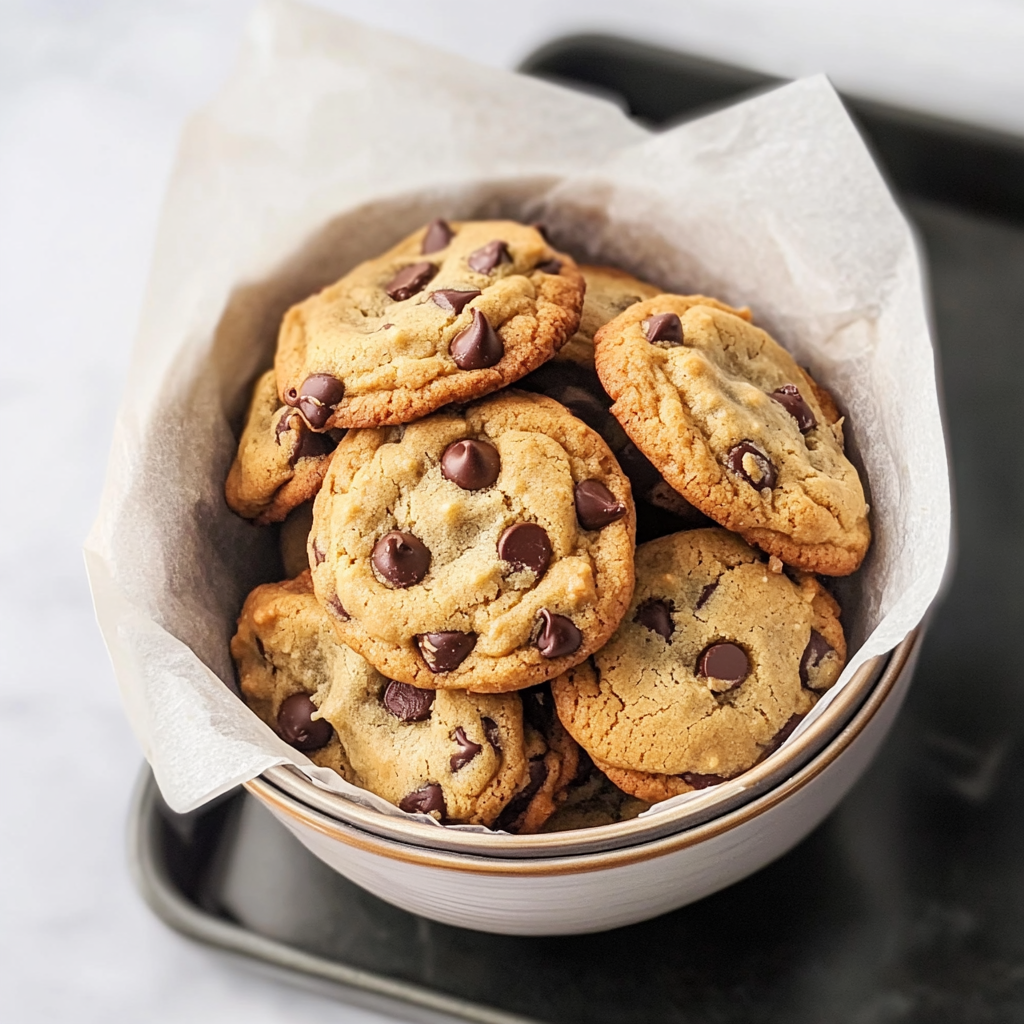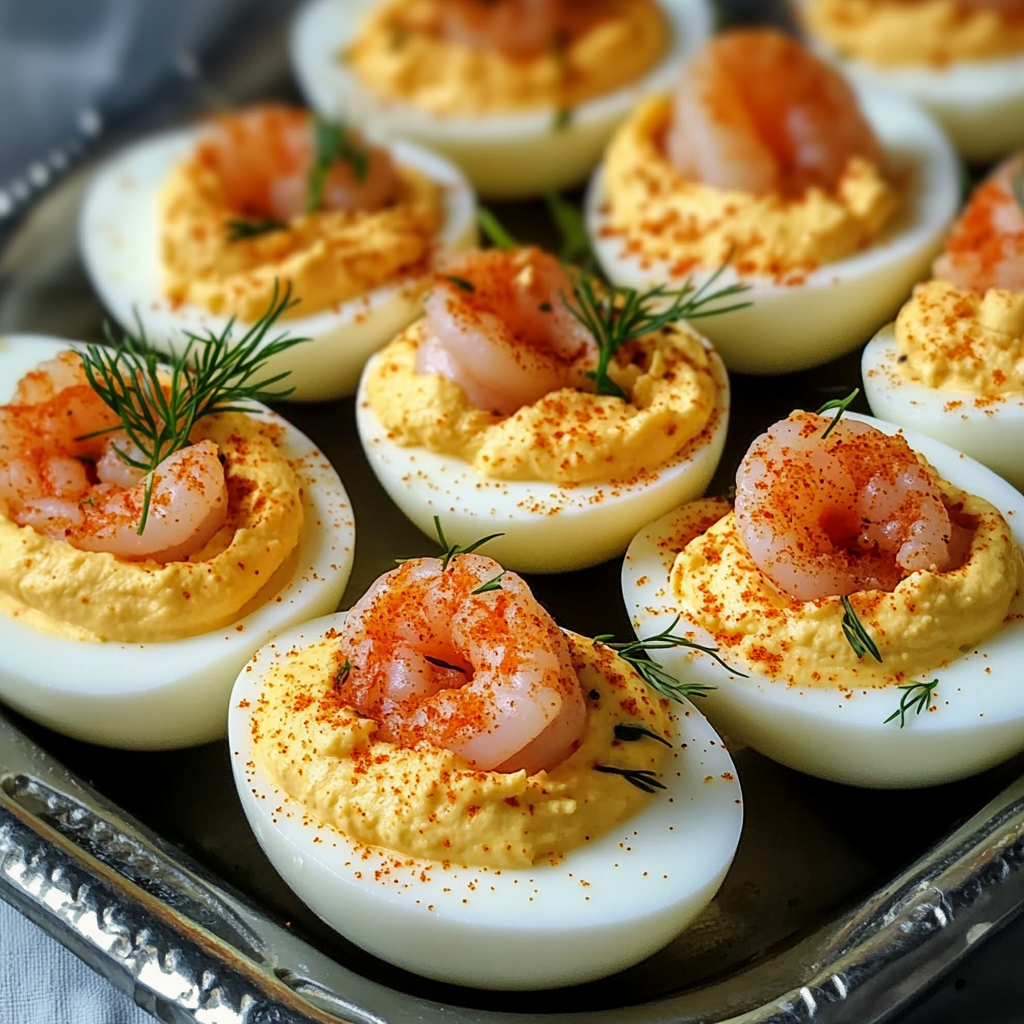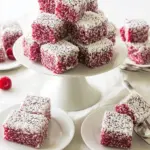Thick chocolate chip cookies are a true indulgence for any dessert lover. This recipe delivers a cookie that’s golden and crisp on the edges, yet soft and gooey in the middle, with generous pools of melted chocolate throughout every bite.
Perfectly balanced with rich buttery dough and just the right amount of sweetness, these cookies are ideal for baking on a cozy afternoon or sharing during celebrations. Whether you enjoy them warm out of the oven or saved for a midnight snack, these classic cookies are sure to satisfy every craving.
Full Recipe
Ingredients:
-
225g unsalted butter, cold and cubed
-
200g light brown sugar
-
100g granulated sugar
-
2 large eggs
-
2 tsp vanilla extract
-
350g plain flour (all-purpose flour)
-
1 tsp baking powder
-
½ tsp baking soda
-
½ tsp salt
-
300g milk or dark chocolate chips (or chunks)
Directions:
-
Preheat your oven to 180°C (350°F). Line two baking trays with parchment paper.
-
In a large bowl, beat the cold, cubed butter with both sugars until creamy and well combined.
-
Add the eggs one at a time, beating well after each addition. Mix in the vanilla extract.
-
In a separate bowl, whisk together flour, baking powder, baking soda, and salt.
-
Gradually mix the dry ingredients into the wet mixture until a dough forms.
-
Fold in the chocolate chips until evenly distributed throughout the dough.
-
Divide the dough into 10–12 large balls, placing them spaced apart on the trays.
-
Bake for 12–14 minutes or until the edges are golden and the centers are slightly underbaked.
-
Let the cookies cool on the tray for 10 minutes before transferring to a wire rack.
Prep Time: 15 minutes | Cooking Time: 14 minutes | Total Time: 29 minutes
Kcal: 415 kcal | Servings: 12 cookies
The Ultimate Guide to Thick Chocolate Chip Cookies
Thick chocolate chip cookies have long held a special place in the hearts (and stomachs) of dessert lovers everywhere. There’s something uniquely comforting about a cookie that’s crisp on the outside, soft and gooey in the center, and studded with generous pockets of melty chocolate. Unlike thin, crispy cookies that rely on caramelization and a crackling texture, thick cookies deliver a satisfying bite that feels hearty and indulgent.
Whether you’re a seasoned baker or a beginner in the kitchen, mastering the perfect thick chocolate chip cookie is a rewarding journey. In this article, we’ll dive deep into the background, techniques, science, and variations that make these cookies so special. If you’re planning to feature them on your blog or sell them in a bakery, this post is designed to equip you with everything your readers need to know—minus the actual recipe steps.
What Makes a Cookie “Thick”?
A thick cookie isn’t just about piling up dough and hoping for the best. There are specific techniques and ingredient choices that help create that signature thickness without compromising the texture or flavor.
Key factors that contribute to thickness include using cold butter (instead of softened or melted), a slightly higher ratio of flour to fat, and proper chilling time before baking. Cold butter and chilling prevent the cookie from spreading too much in the oven, helping it retain a lifted, dense profile. The inclusion of baking powder (alongside or instead of baking soda) also adds a slight lift, resulting in a puffy, soft bite that doesn’t go flat.
The Texture Factor: Crunch Meets Chew
Texture is everything when it comes to baked goods, and thick cookies are a masterclass in contrast. The outer edges should develop a gentle golden crust, providing a slight crunch that gives way to a soft, chewy middle. This balance comes down to precise control of baking time and dough temperature.
Overbaking leads to a cakey or dry cookie, while underbaking risks a raw center. The trick is pulling them from the oven just as the edges begin to color but the middle still looks a little soft. They’ll continue to cook on the baking sheet, firming up without drying out. It’s this technique that leaves you with a melt-in-your-mouth interior every time.
Why Use Cold Butter Instead of Softened?
Traditional cookie recipes call for room temperature butter so it can cream with sugar easily. However, thick cookie recipes often start with cold, cubed butter. This change drastically alters the texture and structure of the final cookie.
Cold butter slows down how quickly the dough spreads in the oven. That reduced spread creates a thicker profile and a more defined texture. Additionally, beating cold butter with sugar gives the cookie dough a sturdier base and allows for more air to be whipped in, which leads to that fluffy, soft interior without going flat during baking.
The Chocolate: Chunks, Chips, or Chopped?
While the type of chocolate might seem like a small detail, it plays a big role in the overall experience of your cookie. Classic chocolate chips are convenient and consistent, but they often don’t melt as dramatically as chopped chocolate bars or couverture chocolate discs.
For the ultimate indulgent bite, use a mix of chocolate chips and hand-chopped chunks from a high-quality chocolate bar. The chips maintain structure and familiarity, while the chopped pieces melt into gooey pools that create visually stunning and deeply flavorful cookies. Milk chocolate makes the cookies sweeter and creamier, while dark or semi-sweet chocolate balances the richness with a bitter edge.
How Chill Time Changes Everything
One of the most overlooked elements in thick cookie recipes is the importance of chilling the dough. Letting the dough rest—even for just 30 minutes—helps hydrate the flour, intensify the flavors, and further reduce unwanted spreading.
When cookie dough is chilled, the fats solidify. Once the dough hits the oven, those solidified fats take longer to melt, meaning the cookies retain more height and structure. In some cases, chilling the dough overnight can dramatically improve the depth of flavor thanks to the Maillard reaction being optimized by better-developed sugars.
The Role of Brown Sugar
Brown sugar is not only about sweetness—it’s about moisture and chew. A cookie made with only granulated sugar may be crisp and sweet, but it lacks the chewiness that brown sugar delivers.
Using a higher ratio of light brown sugar (or even dark brown sugar for added molasses richness) contributes to the thick, fudgy texture that makes bakery-style cookies stand out. The molasses in brown sugar retains moisture and lends a deeper, more complex flavor than plain white sugar.
Common Mistakes to Avoid
Even experienced bakers can run into trouble when aiming for perfect thick cookies. Here are some frequent issues and how to avoid them:
-
Overmixing the dough: This can lead to tough cookies due to excess gluten formation. Mix only until the ingredients are combined.
-
Incorrect butter temperature: Soft or melted butter will spread more in the oven, making the cookies flatter. Start with cold, cubed butter.
-
Skipping the chill time: Dough that isn’t chilled may spread too much and lose its thickness.
-
Overbaking: Thick cookies continue to cook after being removed from the oven. Bake until just set, not fully firm.
-
Measuring flour incorrectly: Too little flour leads to spread; too much makes cookies dry. Always spoon and level flour into your measuring cup or weigh it with a scale for precision.
Variations You Can Try
Once you’ve nailed the base recipe, the sky’s the limit. You can play around with flavor additions and mix-ins to make these cookies uniquely your own:
-
Add a pinch of sea salt on top for a sweet-salty balance that enhances the chocolate.
-
Mix in chopped toasted nuts (like pecans or walnuts) for a crunchy bite.
-
Swap chocolate for white chocolate or butterscotch chips to change the flavor profile.
-
Add espresso powder to deepen the chocolate flavor.
-
Stir in dried fruit, like cranberries or cherries, for a chewy, tangy element.
Storage Tips for Maximum Freshness
Thick chocolate chip cookies are best enjoyed fresh, ideally warm from the oven. But if you have leftovers, store them in an airtight container at room temperature for up to 4 days. To keep them soft, place a slice of bread in the container—it helps regulate moisture.
Cookies can also be frozen before or after baking. For raw dough, scoop individual portions and freeze on a tray before transferring them to a freezer bag. Bake from frozen, adding 1–2 minutes to the bake time. For already baked cookies, wrap them well and freeze for up to 3 months. A quick 10-second microwave refreshes their softness.
Why People Love Thick Cookies
There’s an emotional component to thick cookies that makes them universally adored. Their generous size and texture evoke feelings of home, warmth, and indulgence. They’re not just a snack—they’re a full experience. Whether paired with a cold glass of milk or tucked into a lunchbox, these cookies bring back childhood nostalgia while also appealing to gourmet tastes.
Plus, the visual appeal is unmatched. Those dramatic pools of melted chocolate and the rustic, golden-brown edges make them perfect for sharing on Instagram or serving at parties. They’re equally suited for cozy nights in, celebratory gatherings, or as a thoughtful homemade gift.
Conclusion: Why This Cookie Recipe Is a Must-Bake
In the world of cookies, thick chocolate chip cookies are the ultimate crowd-pleaser. With their rich, chewy centers and perfectly crisp edges, they offer everything you want in a single bite. The secrets lie in small but impactful choices: using cold butter, chilling the dough, balancing sugar ratios, and choosing high-quality chocolate.
If you’re looking to impress guests, treat your family, or simply indulge your own sweet tooth, this thick cookie recipe is the gold standard. It’s simple enough for beginners yet customizable enough for seasoned bakers to make their own. Once you try them, you’ll never settle for thin cookies again.








